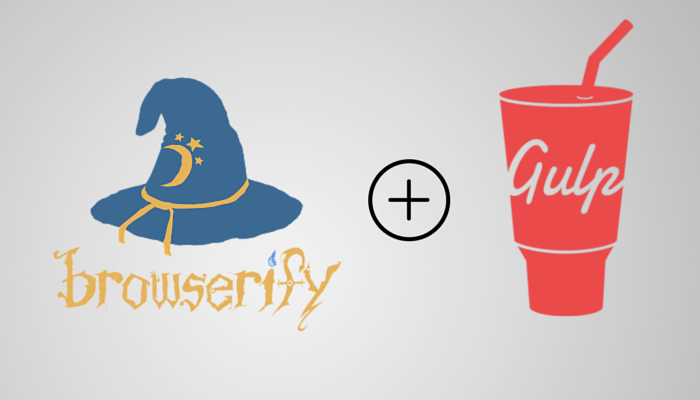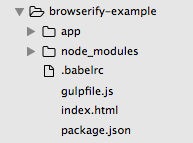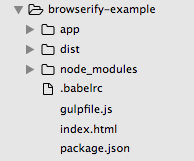Browserify + Gulp + Babelify

在進入第二種方法前,首先先介紹一下會用到 Browserify、Gulp、Babelify 三種前端開發常會用到的工具:
- 如同官網上說明的:
Browserify lets you require('modules') in the browser by bundling up all of your dependencies.,Browserify 是一個可以讓你在瀏覽器端也能使用像 Node 用的 CommonJS 規範一樣,用輸出(export)和引用(require)來管理模組。此外,也能使用許多在 NPM 中的模組
Gulp是一個前端任務工具自動化管理工具。隨著前端工程的發展(Task Runner),我們在開發前端應用程式時有許多工作是必須重複進行,例如:打包文件、uglify、將 LESS 轉譯成一般的 CSS 的檔案,轉譯 ES6 語法等工作。若是使用一般手動的方式,往往會造成效率的低下,所以透過像是 Grunt、Gulp 這類的 Task Runner 不但可以提昇效率,也可以更方便管理這些任務。由於 Gulp 是透過 pipeline 方式來處理檔案,在使用上比起 Grunt 的方式直觀許多,所以這邊我們主要討論的是 Gulp
Babelify是一個使用 Browserify 進行 Babel 轉換的外掛,你可以想成是一個翻譯機,可以將 React 中的JSX或ES6語法轉成瀏覽器相容的ES5語法
初步了解了三種工具的概念後,接下來我們就開始我們的環境設置:
若是電腦中尚未安裝 Node(Node.js 是一個開放原始碼、跨平台的、可用於伺服器端和網路應用的 Google V8 引擎執行執行環境)和 NPM(Node 套件管理器 Node Package Manager。是一個以 JavaScript 編寫的軟體套件管理系統,預設環境為 Node.js,從 Node.js 0.6.3 版本開始,npm 被自動附帶在安裝包中)的話,請先 上官網安裝
用
npm安裝browserify用
npm安裝gulp、gulp-concat、gulp-html-replace、gulp-streamify、gulp-uglify、watchify、vinyl-source-stream開發環境用的套件(development dependencies)// 使用 npm install --save-dev 會將安裝的套件名稱和版本存放到 package.json 的 devDependencies 欄位中 $ npm install --save-dev gulp gulp-concat gulp-html-replace gulp-streamify gulp-uglify watchify vinyl-source-stream安裝
babelify、babel-preset-es2015、babel-preset-react,轉譯ES6和JSX開發環境用的套件,並於根目錄底下設定.babelrc,設定轉譯規則(presets:es2015、react)和使用的外掛// 使用 npm install --save-dev 會將安裝的套件名稱和版本存放到 package.json 的 devDependencies 欄位中 $ npm install --save-dev babelify babel-preset-es2015 babel-preset-react// filename: .babelrc { "presets": [ "es2015", "react", ], "plugins": [] }安裝 react 和 react-dom
$ npm install --save react react-dom撰寫 Component
// filename: ./app/index.js import React from 'react'; import ReactDOM from 'react-dom'; class App extends React.Component { constructor(props) { super(props); this.state = { }; } render() { return ( <div> <h1>Hello, World!</h1> </div> ); } } ReactDOM.render(<App />, document.getElementById('app'));<!-- filename: ./index.html --> <!DOCTYPE html> <html lang="en"> <head> <meta charset="UTF-8"> <title>Hello React!</title> </head> <body> <div id="app"></div> <!-- build:js --> <script src="./dist/src/bundle.js"></script> <!-- endbuild --> </body> </html>設定
gulpfile.js// filename: gulpfile.js // 引入所有需要的檔案 const gulp = require('gulp'); const uglify = require('gulp-uglify'); const htmlreplace = require('gulp-html-replace'); const source = require('vinyl-source-stream'); const browserify = require('browserify'); const watchify = require('watchify'); const babel = require('babelify'); const streamify = require('gulp-streamify'); // 檔案位置參數 const path = { HTML: 'index.html', MINIFIED_OUT: 'bundle.min.js', OUT: 'bundle.js', DEST: 'dist', DEST_BUILD: 'dist/build', DEST_SRC: 'dist/src', ENTRY_POINT: './app/index.js' }; // 複製 html 到 dist 資料夾中 gulp.task('copy', function(){ gulp.src(path.HTML) .pipe(gulp.dest(path.DEST)); }); // 監聽檔案是否有變化,若有變化則重新編譯一次 gulp.task('watch', function() { gulp.watch(path.HTML, ['copy']); var watcher = watchify(browserify({ entries: [path.ENTRY_POINT], transform: [babel], debug: true, })); return watcher.on('update', function () { watcher.bundle() .pipe(source(path.OUT)) .pipe(gulp.dest(path.DEST_SRC)) console.log('Updated'); }) .bundle() .pipe(source(path.OUT)) .pipe(gulp.dest(path.DEST_SRC)); }); // 執行 build production 的流程(包括 uglify、轉譯等) gulp.task('copy', function(){ browserify({ entries: [path.ENTRY_POINT], transform: [babel], }) .bundle() .pipe(source(path.MINIFIED_OUT)) .pipe(streamify(uglify(path.MINIFIED_OUT))) .pipe(gulp.dest(path.DEST_BUILD)); }); // 將 script 引用換成 production 的檔案 gulp.task('replaceHTML', function(){ gulp.src(path.HTML) .pipe(htmlreplace({ 'js': 'build/' + path.MINIFIED_OUT })) .pipe(gulp.dest(path.DEST)); }); // 設定 NODE_ENV 為 production gulp.task('apply-prod-environment', function() { process.env.NODE_ENV = 'production'; }); // 若直接執行 gulp 會執行 gulp default 的任務:watch、copy。若跑 gulp production,則會執行 build、replaceHTML、apply-prod-environment gulp.task('production', ['build', 'replaceHTML', 'apply-prod-environment']); gulp.task('default', ['watch', 'copy']);成果展示 到目前為止我們的資料夾的結構應該會是這樣:

接下來我們透過在終端機(terminal)下
gulp指令來處理我們設定好的任務:// 當只有輸入 gulp 沒有輸入任務名稱時,gulp 會自動執行 default 的任務,我們這邊會執行 `watch` 和 `copy` 的任務,前者會監聽 `./app/index.js` 是否有改變,有的話則更新。後者則是會把 `index.html` 複製到 `./dist/index.html` $ gulp當執行完
gulp後,我們可以發現多了一個dist資料夾
如果我們是要進行
production的應用程式開發的話,我們可以執行:// 當輸入 gulp production 時,gulp 會執行 production 的任務,我們這邊會執行 `replaceHTML`、`build` 和 `apply-prod-environment` 的任務,`build` 任務會進行轉譯和 `uglify`。`replaceHTML` 會取代 `index.html` 註解中的 `<script>` 引入檔案,變成引入壓縮和 `uglify` 後的 `./dist/build/bundle.min.js`。`apply-prod-environment` 則是會更改 `NODE_ENV` 變數,讓環境設定改為 `production`,有興趣的讀者可以參考[React 官網說明](https://facebook.github.io/react/downloads.html) $ gulp production此時我們可以在瀏覽器上打開我們的
./dist/hello.html,就可以看到Hello, world!了!
(image via srinisoundar、sitepoint、keyholesoftware、survivejs)